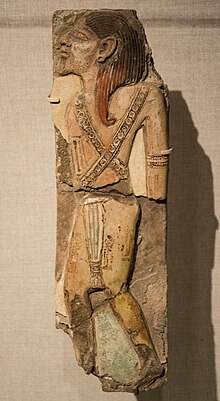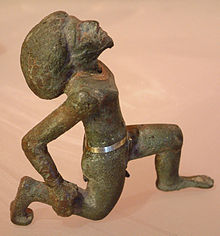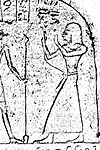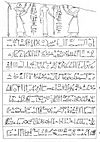Libu
| Libu inhieroglyphs | |||||||
|---|---|---|---|---|---|---|---|
rbw | |||||||

TheLibu(Ancient Egyptian:rbw;also transcribedRebu,Libo,Lebu,Lbou,Libou) were anAncient Libyantribe ofBerberorigin, from which the nameLibyaderives.[1]
Early history
[edit]

Their tribal origin inAncient Libyais first attested inEgyptian languagetexts from theNew Kingdom,especially from theRamesside Period.The earliest occurrence is in aRamesses IIinscription.[2]There were no vowels in the Egyptian script. The name Libu is written asrbwin Egyptian hieroglyphs. In theGreat Karnak Inscription,the pharaohMerneptahdescribes the Libu as men with pale complexion, tattooed, and with dark hair and eyes.[citation needed]
Hostilities betweenEgyptand Libya broke out in regnal year 5 (1208 BCE) and how a coalition of Libu andSea Peoplesled by the chief of the LibuMeryeywas defeated.[3][4]Libuappears as an ethnic name ontheMerneptah Stele,also known as theIsrael Stele.[5]
Ramesses IIIdefeated the Libyans in the 5th year of his reign, but six years later the Libyans joined theMeshweshand invaded the western Delta and were defeated again.[6]
This nameLibuwas taken over by theGreeksofCyrenaica,who co-existed with them.[7]Geographically, the name of this tribe was adopted by the Greeks for "Cyrenaica" as well as for northwestern Africa in general.[8]
In the neo-Punicinscriptions,Libuwas written asLbyfor themasculinenoun, andLbtfor thefemininenoun ofLibyan.The name supposedly was used as an ethnic name in those inscriptions.[9]
Great Chiefs of the Libu
[edit]In the WesternNile Delta,some time during the22nd Dynasty of Egyptflourished a realm of the Libu led by "Great Chiefs of the Libu".[10]Those rulers soon formed a dynasty, and they often had local "Chiefs of theMa(shuash)"as their subordinates. The dynasty culminated with the chiefdom ofTefnakhtwho, despite holding both the titles of "Great Chief of the Libu" and of "Chief of the Ma" atSais,was more probably of Egyptian ethnicity rather than either Libu or Ma.[11]Later, Tefnakht claimed for himself even thepharaonictitles, founding the24th Dynasty.[12]
Here follows the succession of the known "Great Chiefs of the Libu". They used to date their monuments following theregnal yearsof the contemporary pharaoh of the 22nd Dynasty.[13]
| Name | Image | Attested in regnal year... | Corresponding absolute datation | Notes |
|---|---|---|---|---|
| Inamunnifnebu |  |
Year 31 ofShoshenq III[13] | 795 BCE | - |
| Niumateped |  |
Year 4 ofShoshenq IV Year 8 of Shoshenq IV Year 10 of Shoshenq IV[14] |
- BCE | Possibly two different rulers with the same name |
| Tjerpahati |  |
Year 7 ofShoshenq V Year 15 of Shoshenq V[14] |
760 BCE 753 BCE |
Also known in literature as Tjerper or Titaru, son of Didi |
| Ker |  |
Year 19 of Shoshenq V[13] | 749 BCE | - |
| Rudamun | Year 30 of Shoshenq V[13] | 738 BCE | - | |
| Ankhhor | Year 37 of Shoshenq V Year? of Shoshenq V[13] |
731 BCE ?BCE |
Struggled against Tefnakht and was likely defeated by him | |
| Tefnakht |  |
Year 36 of Shoshenq V Year 38 of Shoshenq V[13] |
732 BCE 730 BCE |
- |
See also
[edit]References
[edit]- ^Zimmermann, K. (2008)."Lebou/Libou".Encyclopédie berbère.Vol. 28-29 | Kirtēsii – Lutte. Aix-en-Provence: Edisud. pp. 4361–4363.doi:10.4000/encyclopedieberbere.319.
- ^Clark, Desmond J. (ed.) (1982) "Egypt and Libia"The Cambridge History of Africa: From the earliest times to c. 500 BCvolume I, Cambridge University Press, Cambridge, England, p. 919,ISBN0-521-22215-X
- ^Breasted, James H. (1906)Ancient Records of Egypt,Part Three, Chicago, §§572ff.
- ^Manassa, Colleen(2003).The Great Karnak Inscription of Merneptah: Grand Strategy in the 13th Century B.C.New Haven: Yale Egyptological Seminar.ISBN9780974002507.
The seventy-nine line inscription is located on the interior of the east wall of the "Cours De la Cachette," directly north of a copy of the Hittite treaty from the reign of Ramesses II and in conjunction with other reliefs of Merneptah (PM II, p. 131 [486])... Unfortunately, the excavation of the Cours De la Cachette between 1978-1981 by the French expedition at Karnak did not discover any new blocks belonging to the Great Karnak Inscription of Merneptah, although it did demonstrate that the court was filled with many ritual and religious scenes in addition to its known military themes (F. LeSaout, "Reconstitution des murs de la Cours De la Cachette," Cahiers De Karrah VII (1978-1981) [Paris, 1982], p. 214).
- ^[...] The vile chief of theLibuwho fled under cover of night alone without a feather on his head, his feet unshod, his wives seized before his very eyes, the meal for his food taken away, and without water in the water-skin to keep him alive; the faces of his brothers are savage to kill him, his captains fighting one against the other, their camps burnt and made into ashes [...]AfterGardiner, Alan Henderson (1964)Egypt of the Pharaohs: an introductionOxford University Press, London, p. 273,ISBN0-19-500267-9
- ^J. H. Breasted,Ancient Records of Egypt,Part Four, Chicago 1906, §§83ff. Afterward, the name appeared repeatedly in otherpharaonic records.
- ^Fage, J. D. (ed.) (1978) "The Libyans"The Cambridge History of Africa: From c. 500 BC to AD 1050volume II, Cambridge University Press, Cambridge, England, p. 141,ISBN0-521-21592-7
- ^"Libya".Online Etymology Dictionary.Retrieved2016-11-24.
- ^Thomas C. Oden (2011).Early Libyan Christianity: Uncovering a North African Tradition.InterVarsity Press. p. 51.ISBN978-0830869541.
- ^O'Connor, David. "Egyptians and Libyans in the New Kingdom"Expedition Magazine29.3. Penn Museum, 1987
- ^P.R. Del Francia, "Di una statuetta dedicata ad Amon-Ra dal grande capo dei Ma Tefnakht nel Museo Egizio di Firenze", S. Russo (ed.) Atti del V Convegno Nazionale di Egittologia e Papirologia, Firenze, 10-12 dicembre 1999, Firenze, 2000, p. 94
- ^Kitchen, Kenneth A.(1996).The Third Intermediate Period in Egypt (1100–650 BC).Warminster: Aris & Phillips Limited.ISBN0-85668-298-5.,§ 249; 306
- ^abcdefBerlandini, Jocelyne (1978). "Une stèle de donation du dynaste libyen Roudamon".BIFAO.78:162.
- ^abJansen-Winkeln, Karl (2014)."Die" Großfürsten der Libu "im westlichen Delta in der späten 22. Dynastie"(PDF).Journal of Egyptian History.7(2): 194–202.doi:10.1163/18741665-12340017.
